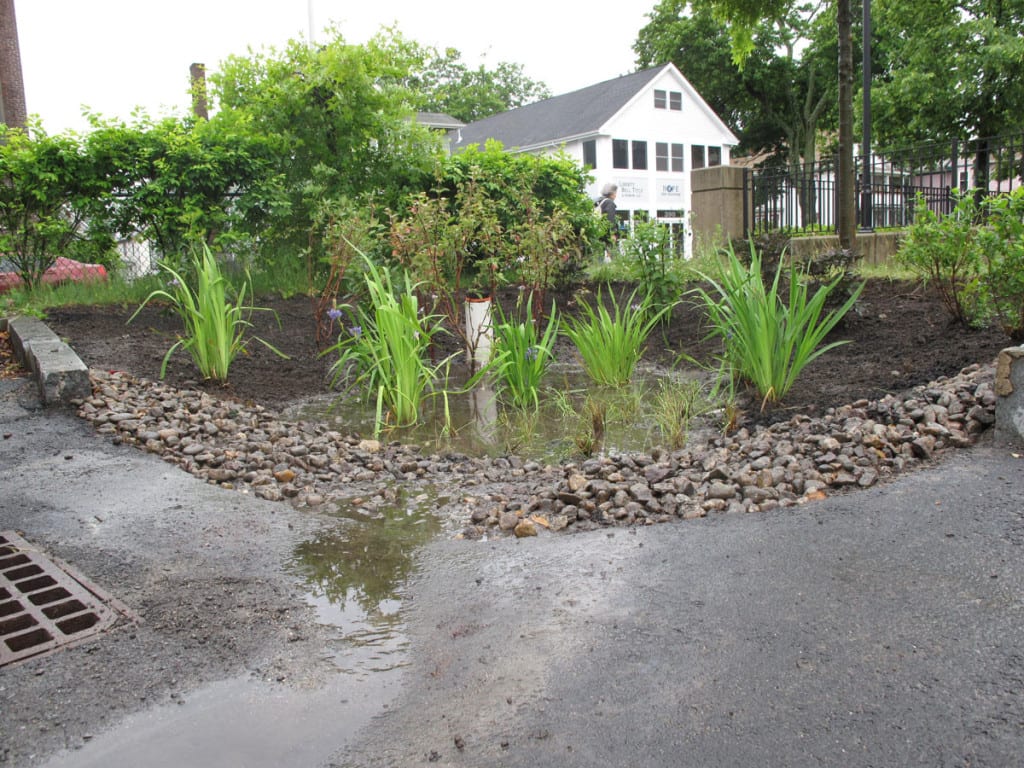by Clay Larsen
A case of illegal dumping helped to fund a lesson for sixth graders on stormwater management and how manmade rain gardens can clean up polluted rivers and streams.
A rain garden retrofit project that I led for an afterschool program at the Beebe School in Malden, MA was funded through a federal legal settlement with a contractor who illegally dumped fill into a wetland. As a landscape designer and teacher from Malden, I coordinated and customized the project along with the Mystic River Watershed Association and the Department of Environmental Protection.
Rain gardens in their simplest form are manmade depressions in the ground that catch water draining from parking lots, walkways, roofs, or other surfaces that do not absorb water. They have become more sophisticated as engineers and landscape architects build them for a variety of needs and in various sizes.
Learning by Doing
The project was the city’s first to feature low impact development and was also a good match for the K-8 school’s environmental and health science theme. Students learned about the natural and manmade ecosystems of Malden, including the Malden River and Malden’s Fellsmere Pond, as well as how the city’s storm drains work and how urbanization has changed the local environment.

Students at the Beebe School in Malden, MA assist with planting native shrubs in the city’s first rain garden project.
The project at the Beebe School was chosen after the Department of Environmental Protection reached out to the Mystic River Watershed Association (MyRWA). MyRWA contacted me and I developed conceptual sketches that led to the project being adapted to the court settlement. The contractor agreed to work on the project instead of facing other penalties and to provide the heavy equipment for digging and installing drainage and soil.
The project provided students with an opportunity not only to study the environment but to experience restoring it. They studied the process of building the rain garden: looking at the engineering drawings, watching the contractor work, and learning about different types of plants. They also helped create signs that explain the project to others and assisted with the planting process. The rain garden will continue to be used as a teaching tool, as students study the growth of native plants and watch how the rain garden functions in wet and dry weather.
Location, location
The rain garden is located in a small patch of grass at the bottom of the parking lot near the Beebe School’s front entrance. A catch basin is conveniently located close by. A large hole was dug approximately five feet deep by ten feet across. Granite curbing was removed from the front of the lawn and asphalt was cut back and reset around the catch basin to allow water to bypass it and drain into the hole in the lawn.
The hole was filled back up with four feet of 1.5-inch stone with a layer of pea stone and a layer of sandy loam to provide drainage. Water from the entire 16,000-square-foot parking lot drains into the rain garden, soaking into the ground. In large storms the overflow drains back into the catch basin. The surface area of the rain garden is about 360 square feet, with an estimated storage capacity of 500 cubic feet of stormwater.

During periods of low flow, water bypasses the storm drain at left, filters through gravel check dam, then pools in the rain garden’s low area and soaks into ground
Rain gardens are a good way to let nature clean up problems created by man.
Historically, humans altered the environment as they built places to live, work, and play. They filled in low area and wetlands without realizing their value. What was once perceived as a muddy puddle breeding mosquitoes and slimy things, such as frogs and snakes, is now understood to be a piece of natural infrastructure that cleans and holds water, in addition to providing homes for song birds and butterflies.
Man-made rain gardens mimic these natural wetlands and are a simple technology that landscapers and homeowners can easily build with a little training.
The rain garden retrofit project in Malden showed how communities can create solutions for environmental violations that educate violators and others. In this project the contractor learned about the community’s interest in keeping the environment clean and how to build rain gardens. Students working on the project learned about rain gardens and their potential to clean up local rivers and stream.
The city of Malden benefited by gaining a rain garden that city officials and the general public can use as a reference point for developing future green infrastructure projects.
About the Author
Clay Larsen is a landscape designer, construction supervisor, nurseryman, teacher, and artist. Larsen’s experience includes design, permitting, hands-on construction experience, and training on projects in sensitive natural resource areas such as river fronts, flood plains, and wetlands. With his additional knowledge of erosion and sedimentation issues, Clay’s goal is to knit back together damaged ecosystems. He has worked on Rain Gardens, Green Roofs, and Rainwater Harvesting Systems and other types of low impact development tools to help address flooding and pollution in rivers and streams.

